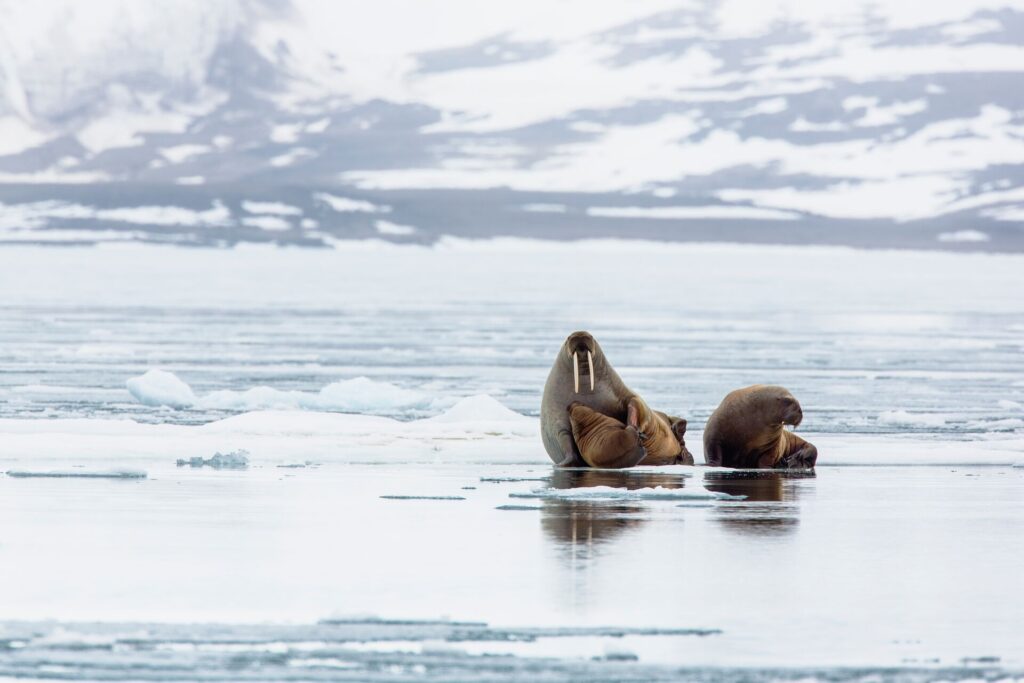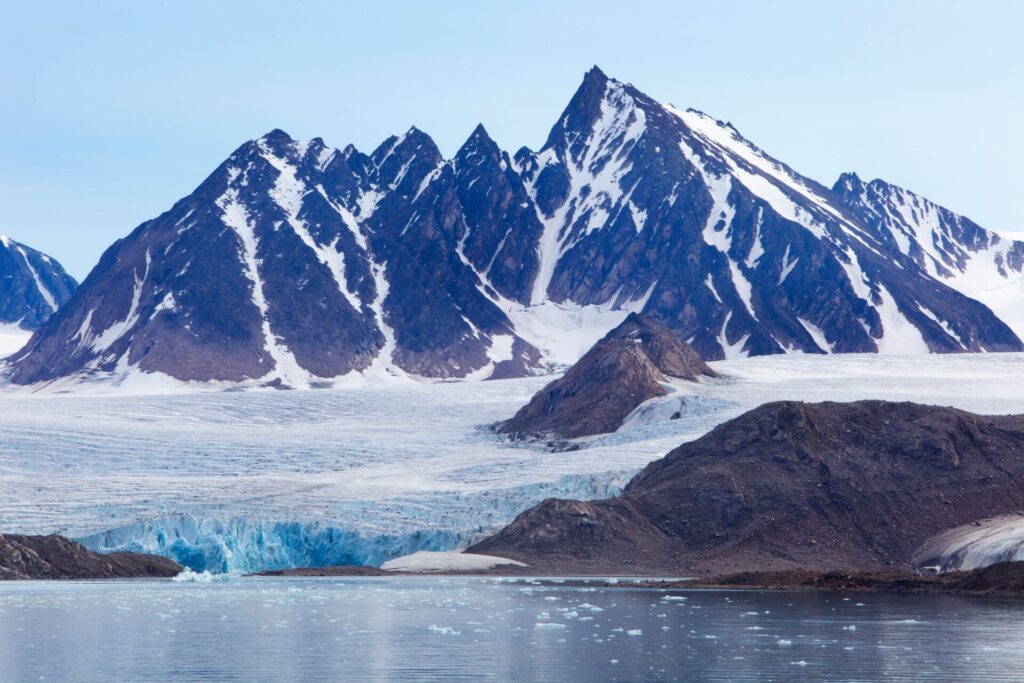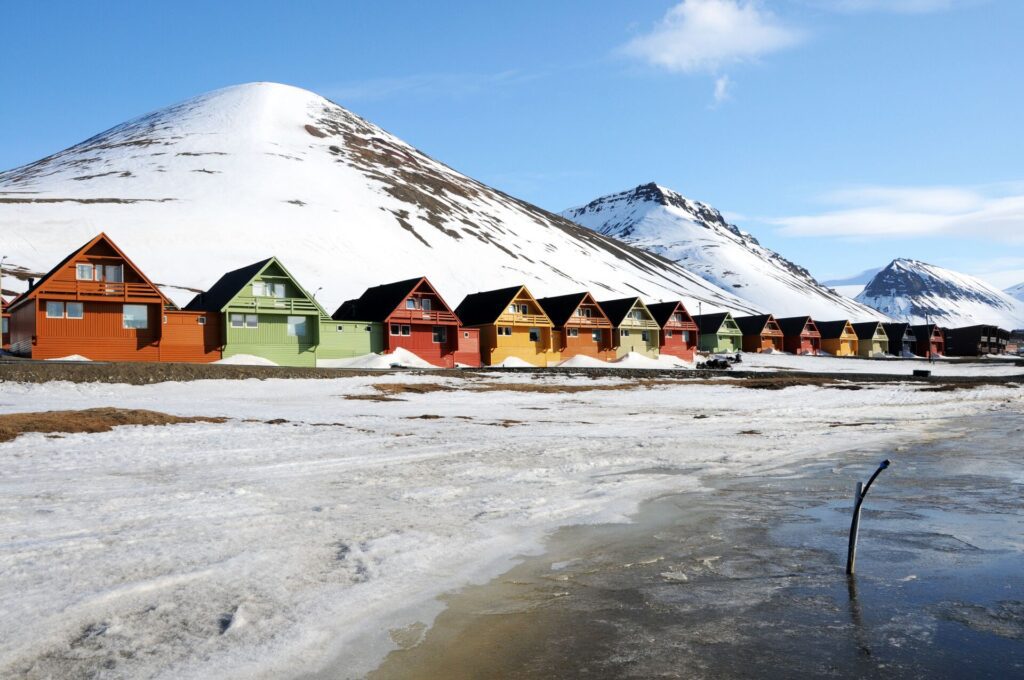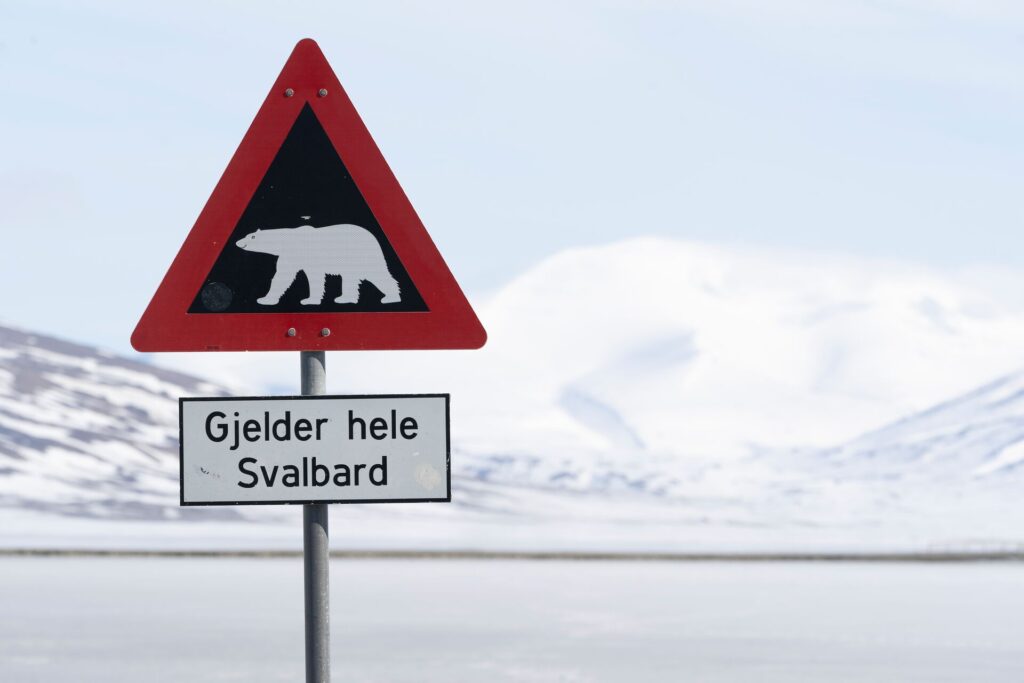Recently updated on September 19th, 2025 at 04:46 am
Crowning the planet with blues, silvers, and whites, Svalbard might feel like the final frontier of Arctic exploration – but getting there is easier than you might think. This remote Norwegian archipelago lies roughly halfway between mainland Norway and the North Pole, scattered between 74° and 81° north in the Arctic Ocean, with Spitsbergen the largest and most accessible of its nine main islands (check out this map for details).
Its main town, colourful Longyearbyen, serves as civilisation’s last stop before the high Arctic’s unfettered wilderness sets the scene for everything from northern lights excursions and glacier hikes, to small-ship expedition cruises. And while human life is scarce in Svalbard – less than 3000 people live across its 62,700km² area – these frosty lands and seas bustle with life as polar bears, whales, walruses, Arctic foxes, reindeer and seabirds claim its various national parks and nature reserves.
Ready to unleash your inner polar explorer and discover it all and more? This complete guide reveals exactly how to visit Svalbard for an adventure that’ll put you on top of the world – in more ways than one.


Why You Should Visit Svalbard
While there are probably as many reasons to visit Svalbard as there are islets across the archipelago (hint: too many to count), you can get started with these standouts…
For the northern lights
As Svalbard sits beneath the auroral oval, provided the solar activity aligns and there’s no cloud cover, October to late February is a great time to see them, with mid-Nov to late Jan bringing 24-hour darkness. The best spots near Longyearbyen are Adventdalen and Camp Barentz, or out on the water away from any light pollution. To maximise your chances, check out our story, the best times and places to see the Northern Lights.
For glacier and midnight sun adventures
About 60 per cent of Svalbard is covered in glaciers, with Foxfonna, Nordenskiöldbreen (Billefjorden), Tunabreen (Tempelfjorden) among the top options for adventurers. Under the midnight sun (usually between late April and late August), you can hike, trek on glacier forefields and plateaus.
For epic small-ship expedition cruises
Small expedition ships get you into fjords, icy areas and landing sites that are otherwise unreachable, with expert guides leading the way. Keep an eye out for ethical, sustainability-focused operators like Lindblad Expeditions-National Geographic and Hurtigruten, who host responsible expeditions that tread lightly on this fragile environment in line with best-practice standards outlined by the Association of Arctic Expedition Cruise Operators.
For unique wildlife experiences
Svalbard lies within the Barents Sea polar bear range, with a subpopulation in the low thousands; and, depending on when you visit, you might also encounter beluga, minke, humpback, fin and occasionally blue whales. Walruses are also a highlight here – about 5,500 live in the area – and when you visit Longyearbyen with Adventure World, you can MAKE TRAVEL MATTER® with a safari aboard a hybrid-electric catamaran, designed for unobtrusive wildlife watching.
For its remoteness
Longyearbyen is a former coal company town turned research-and-adventure hub, perched right on the Isfjorden – Spitsbergen’s largest fjord system. And while it has museums, galleries, good dining and gear shops, it sits right on the doorstep of the Arctic wilderness. Other smaller, more remote towns such as Barentsburg, Ny-Ålesund and Pyramiden are less accessible.
Our fully customisable Authentic Svalbard journey takes in the very best of the region by land and sea, offering a choice of departures between June to September.


Do You Need a Visa to Visit Svalbard?
Probably not. You’ll still need to show your passport, but no visa is required for entering Svalbard itself. That said, because you’ll pass through mainland Norway to get there (and it’s in the Schengen Area), you’ll need to meet the Schengen entry requirements to enter the country without a visa. Per Smartraveller, Australians can visit Schengen countries (including Norway) visa-free for up to 90 days; the same applies to Kiwis, with SafeTravel advising that New Zealand citizens can travel visa-free for short stays. But, as these entry requirements often change, check both websites before you book your holiday and, if you do end up needing a visa, ensure it is multi-entry (so you can return to the mainland after your Svalbard adventure).
How to Get to Svalbard
As the Svalbard archipelago lies about 960km north of Tromsø, it’ll take a journey by plane or ship (or a combination of both) to get there.
Travelling to Svalbard by Sea
Most expedition cruises embark in Longyearbyen (so you’ll fly to Svalbard first) but some longer itineraries sail from mainland Norway, notably Hurtigruten’s Svalbard Line from Bergen.
Flying to Svalbard
Direct flights to Longyearbyen operate only within Norway – so you’ll connect via Oslo or Tromsø. The flight from Oslo takes about three hours, while it’s around 90 minutes from Tromsø, with Scandinavian Airlines (SAS) and Norwegian operating both routes.
Getting to Svalbard from Australia & New Zealand
From Australia or New Zealand, fly to Oslo via a major Asian, Middle Eastern or European hub, then connect to Bergen or Longyearbyen (direct from Oslo or via Tromsø).
Arriving in Longyearbyen: Airport Transfers & Local Transport
Taxis operate from the airport terminal, and a shuttle bus meets all scheduled flights for transfers to hotels and guesthouses. Within town limits Longyearbyen is compact and walkable (do not go beyond the polar-bear warning signs without proper protection, or preferably, a guide). In summer, you can rent a city bike from the Svalbard Tourist Information office to get around the town.


How to Get Around Svalbard
As Svalbard is vast and challenging, exploring beyond Longyearbyen independently is both impractical and dangerous. So, your best bet is to stick with fully guided options and expedition cruises.
Transport Within Spitsbergen
Because travel here requires proper protection against polar bears and expert know-how, licensed guides and cruises are your best bet for getting around. There are about 40-50km of roads in and around Longyearbyen, but there are none that connect it to any of Spitsbergen’s other smaller settlements, such as Ny-Ålesund. Travel between these remote outposts and research stations is usually by pre-organised boat charters (summer) or guided snowmobile tours (winter/spring). While limited, weather-dependent flights between Longyearbyen and Ny-Ålesund do exist, they’re for researchers and station staff, rather than visitors.
Excursions Beyond Longyearbyen
As self-driving, local air travel and DIY boating aren’t options for visitors an expedition cruise is the most practical, comfortable option if you’re keen to reach remote fjords, glaciers and see the core wildlife areas across the archipelago.
On our Polar Night Svalbard journey you’ll delve deep into the Arctic winter with northern lights adventures, dogsledding, remote camp experiences, and more.


Best Time to Visit Svalbard
The best time to visit Svalbard depends on whether you want the full summer or winter Arctic experience, because the archipelago has a polar climate with two main seasons. While the midnight sun runs from late April to late August, the wider summer season runs to late September – as the fjords are at their most accessible and wildlife diversity is at its broadest, this is prime time for small-ship expeditions. Winter (October-February) is the northern lights season, with polar night from mid-November to late January bringing 24-hour darkness and round-the-clock aurora opportunities, although volatile weather can limit your options for other activities.
For creature-seekers, polar bears are most often sighted on expedition cruises from May-September, while whales are most frequently observed in the fjords over the summer. And shoulder periods bookend the year: Sunny Winter (from March to mid-May) has long, bright days for snowmobile and sledding adventures, while September–October sees a quieter travel period as darkness (and the aurora) returns.
Travel Tips and Safety Guidelines
A few handy hints to keep top of mind to ensure your Svalbard journey is safe, comfortable and treads light and right.
Weather and Seasonal Conditions
While Svalbard’s conditions are famously changeable, here’s a general look at how Longyearbyen’s weather has played out in recent years, according to the Norwegian Meteorological Institute:
| Jan-Mar | Apr-Jun | Jul-Sep | Oct-Dec |
Mean temperature in °C | -11.6 | -2.5 | 5.0 | -6.3 |
Precipitation (rain/snow) in mm | 54 | 28 | 71 | 66 |
Safety Precautions Outside of Longyearbyen
Polar bears, unpredictable weather, limited visibility, sea ice and glacier hazards are the primary risks you’ll come across in Svalbard, but licensed expedition companies and cruise operators not only have armed guides for bear protection, they’re equipped with all manner of safety kit and emergency communications gear – so follow their instructions at all times. If you’re cruising, your ship will probably have a medical professional on board in case of any emergencies, but you’ll need to bring along all your personal medications for the duration of your trip. And, of course, never leave home without travel insurance.
Protecting Svalbard’s Fragile Landscape
The archipelago is as biodiverse as it is vast. In fact, protected areas cover 65 per cent of the land and 84 per cent of Svalbard’s territorial waters – so it’s essential to respect them accordingly. When you’re walking on the tundra, be aware that it’s home to around 170 vascular plant species, 380 mosses and 600 lichens. Plus, more than 200 species of birds have been recorded, and several marine mammals are protected under the Svalbard Environmental Protection Act. So, always make the effort to stay on durable surfaces and established paths, and if you’re exploring off-track, follow your guide’s route and keep your distance from wildlife to minimise disturbance.


What to Pack for Svalbard
No matter what time of year you visit the archipelago, the principle is the same: layers are key to your safety and comfort. When you’re faced with winter lows around –20°C you can pile them on, and when you’re basking in balmy 6°C days you can peel them off (or wear fewer of them). Start with a merino or technical synthetic thermal base to wick moisture away from your skin, followed by an insulating mid-layer, like fleece or down (or both). Then, seal in all that cosiness with a breathable, waterproof, windproof shell layer. Sturdy winter boots with thermal lining and grippy soles are a must, as are insulated gloves, a windproof beanie and a neck gaiter. Rechargeable hand warmers, head torches, polarised sunglasses and a weatherproof daypack will also come in handy outdoors, as will lip balm, sunscreen and backup camera batteries (the cold zaps their power). Check out our story to learn more about what to pack for Arctic conditions.
Experience Svalbard at its brightest, summer best on our 5-day Midnight Sun Svalbard adventure.
How Much Money You Need to Visit Svalbard
Naturally, your average daily costs will depend on when you visit Svalbard and the type of Arctic adventures you’re after, but to keep expenses in check, bundling your travel needs into one manageable package is your best bet. Adventure World’s customisable Svalbard holidays ensure you can manage most costs up front, so along with things like accommodation and transport, the cost of activities and excursions is factored into your package.
Looking for a Svalbard deal? Aim to book six to 12 months early, keep an eye out for lastminute offers, or travel in the shoulder season. And don’t forget to sign up to Adventure World’s newsletter for exclusive travel discounts – you can subscribe at the bottom of our home page.
Experience unique glacier adventures, dogsledding, snowmobiling and aurora chases on our 5-day Svalbard Sunny Winter holiday.
Final Tips for Planning Your Svalbard Adventure
For the complete Svalbard experience, opt for a combo of land touring and cruising. Along with opportunities for outdoor adventures, staying a few days in Longyearbyen also brings an understanding of how it might feel to live in this remote region, while quality time at sea reveals the true scale and uniqueness of this far-flung marine environment.
Timing your visit to coincide with one of Longyearbyen’s stellar festivals will level up your experience, too, and they’re on throughout the year. In early February the PolarJazz Festival brings the rhythm to winter, then a few weeks later, Solfestuka (Sun Festival Week) celebrates the sun’s return after the winter dark. And for a multisensory immersion in the Arctic’s culinary scene, visit in October for the Taste Svalbard festival. To see what else is happening, keep an eye on Longyearbyen’s local events page.
Plus, as you’ll pass through mainland Norway en route to Svalbard, make time to explore some of its highlights – road trips, alpine hikes, historic train journeys and buzzing modern cities are just the start. Check out our Norway travel guide for your ultimate Nordic to-do list.
